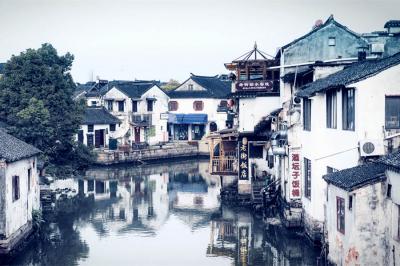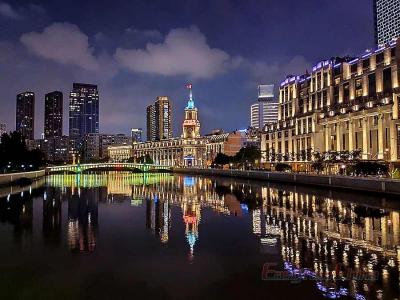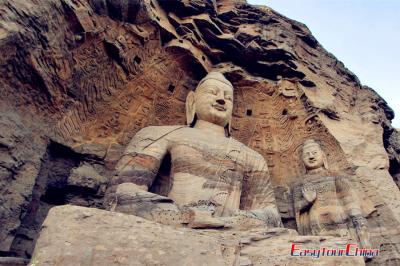Pan Gate (Panmen)
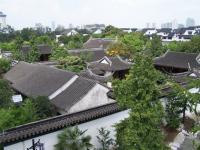 With a history of 2,500 years, Pan Gate stands at the southwestern corner of the ancient city of Suzhou. Walking onto the top of the gate, you can see the Wu Gate Bridge and the Auspicious Light Pagoda. Together, they are popularly known as the Three Scenes at Pan Gate.
With a history of 2,500 years, Pan Gate stands at the southwestern corner of the ancient city of Suzhou. Walking onto the top of the gate, you can see the Wu Gate Bridge and the Auspicious Light Pagoda. Together, they are popularly known as the Three Scenes at Pan Gate.
Construction of Pan Gate began in the first year of the reign of He Lu, King of Wu during the Spring and Autumn Period (770-476 BC). Although it has been renovated and rebuilt many times through the ages, its location has never changed an inch.
The present Pan Gate was rebuilt in the 11th year of the reign of Zhizheng in the end of the Yuan Dynasty (1271-1368) and renovated during the following Ming and Qing dynasties. With water gates and land gates towering side by side, Pan Gate looks very imposing. The land gate consists of double gates, one inside and the other outside, with city walls forming a square terrace of about 20 meters long on each side.
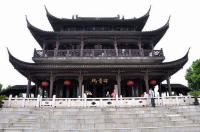 Pan Gate is a fortress suitable for ancient water-towns like Suzhou in the southern part of China. The two water gates adjoining the land gates are the only water pass linking the inside and outside of the southwestern corner of the city. Built with granite, each of them has enough room for two boats passing side by side. For each gate there is a huge sluice gate to control the water flow. It is easy to imagine the prosperous sights then that the double water and land gates of Pan Gate shined on the Grand Canal, when horses and carriages went through the pass with flags fluttering, and boats paddling through the water gates.
Pan Gate is a fortress suitable for ancient water-towns like Suzhou in the southern part of China. The two water gates adjoining the land gates are the only water pass linking the inside and outside of the southwestern corner of the city. Built with granite, each of them has enough room for two boats passing side by side. For each gate there is a huge sluice gate to control the water flow. It is easy to imagine the prosperous sights then that the double water and land gates of Pan Gate shined on the Grand Canal, when horses and carriages went through the pass with flags fluttering, and boats paddling through the water gates.
Wu Gate Bridge is located on the Beijing-Hangzhou Grand Canal beside Pan Gate. Looking like a rainbow hung in the sky, it is the longest stone one-arched bridge in Suzhou. Construction of Wu Gate Bridge began in the Northern Song Dynasty, but the bridge seen today was rebuilt in the Qing Dynasty. As it was the gateway to the Wu state, the bridge was named Wu Gate Bridge.
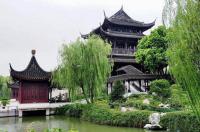 A huge stone arched bridge, Wu Gate Bridge is about six meters high and 63 meters long. In each of its south and north ends, there are 48 steps made out of a whole rectangular slab of five meters long and 0.5 meter wide. The whole Wu Gate Bridge was built with carefully and precisely sculpted granite from the Jinshan Hill and the seams were filled with mixture of alum, glutinous rice soup and lime. That is why the bridge remains as solid as it was newly built, though hundreds of years have passed. On the bridge, one can have a clear view of the gate tower of Pan Gate and the Auspicious Light Pagoda.
A huge stone arched bridge, Wu Gate Bridge is about six meters high and 63 meters long. In each of its south and north ends, there are 48 steps made out of a whole rectangular slab of five meters long and 0.5 meter wide. The whole Wu Gate Bridge was built with carefully and precisely sculpted granite from the Jinshan Hill and the seams were filled with mixture of alum, glutinous rice soup and lime. That is why the bridge remains as solid as it was newly built, though hundreds of years have passed. On the bridge, one can have a clear view of the gate tower of Pan Gate and the Auspicious Light Pagoda.
The Auspicious Light Pagoda was originally an attached building of the Buddhist Monastery of Universal Relief. It was built by Sun Quan, King of Wu, during the Three Kingdoms period. The current Auspicious Light Pagoda was from the early years of the Northern Song Dynasty and its wooden parts went through several renovations during the Song, Ming and Qing Dynasties. It is the second oldest structure of its kind in the Suzhou area, next to the Tiger Hill Pagoda only.
Standing 44.42 meters high, the pagoda is a seven-storey octagon structure. Its elegant figure is reflected in the Grand Canal. And either in daybreak or twilights when sunrays shoot on its body cast upon its roof, the pagoda looks particularly magnificent. If you climb onto the pagoda by following the stairs and looking into the distance, you will have a panoramic view of the picturesque water-land in the Yangtze River Delta.
